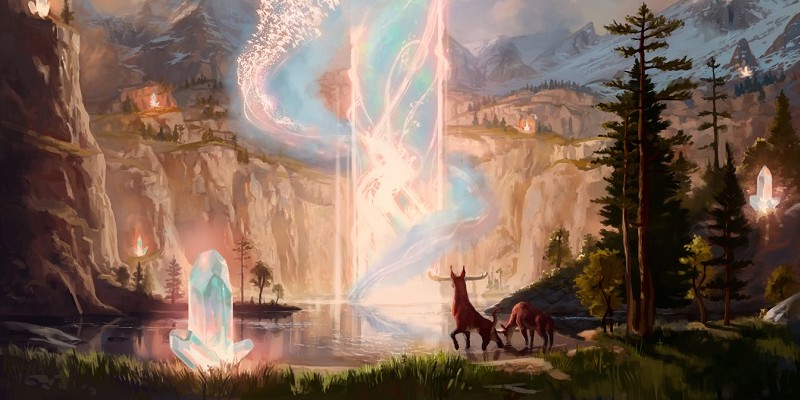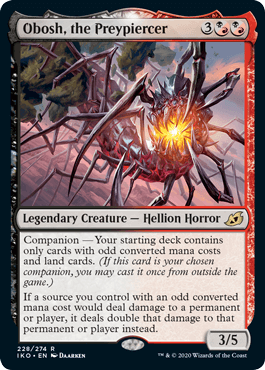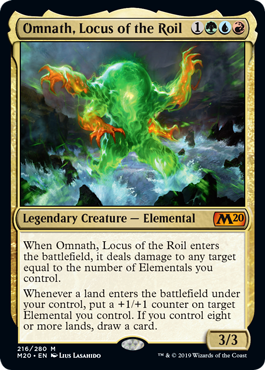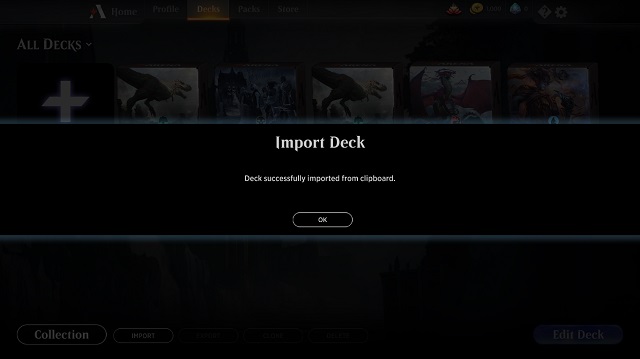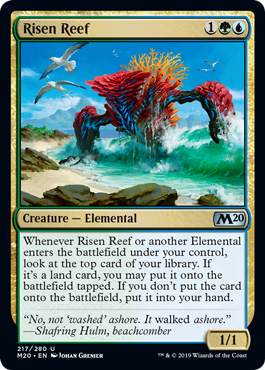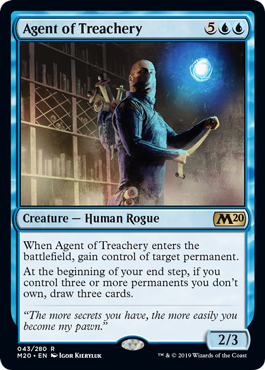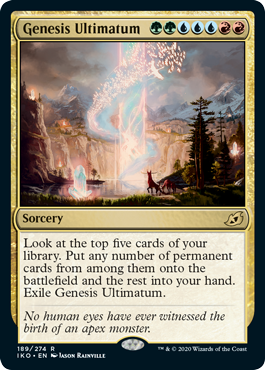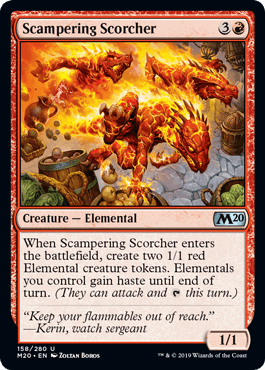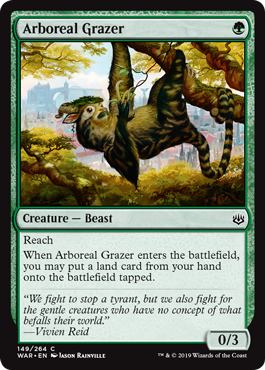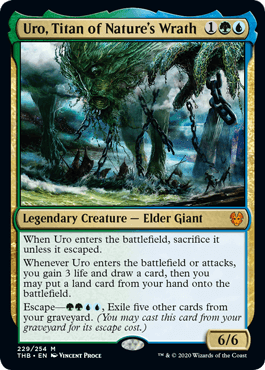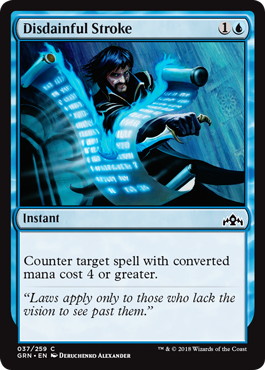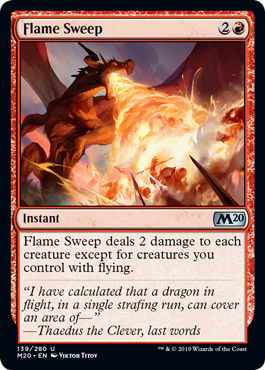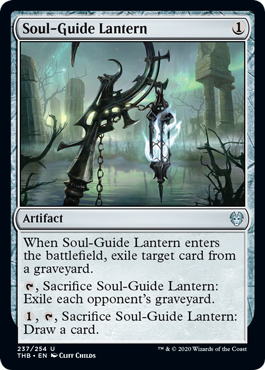State of the Ikoria Standard
Hello! Standard metagame almost reached the full circle. Soon after Ikoria: Lair of Behemoths released we started with Gyruda + 《Spark Double》 combo, that was ‘unbeatable’ for one day. People quickly realized that deck can’t beat a single copy of 《Grafdigger’s Cage》, or a fast and consistent aggro, and they adapted. Next ‘the best deck’ for a week or so was Rakdos Lurrus. As aggro dominated the format, we had the next Companion that raised. Keruga, and the Jeskai Fires. Pre-Ikoria 《Fires of Invention》 deck was well known for great aggro match ups, so it was the best possible time to pick up 《Deafening Clarion》 again. This in fact slowed the metagame and allowed even bigger midrange decks try their chances. Now we have ‘the Yorion Standard’, and the best performing decks are using 80 cards.
To beat Jeskai or Bant Yorions we have two options. Go under them, as Mono Red Obosh did during the MagicFest Online Season 2 Finals, or go even bigger, and build a better late game strategy. As I like long and grindy games, there was only one option for me. I picked up a well known Temur Elementals idea, and build it with one specific goal in mind. Beat the Yorion mirrors.
Temur Yorion Elementals
Decklist and Basics
This is my final build:
- Grzegorz ‘Urlich’ Kowalski
- – Temur Yorion Elementals
- (Standard)
3 《Island》
1 《Mountain》
4 《Ketria Triome》
4 《Breeding Pool》
4 《Steam Vents》
4 《Stomping Ground》
4 《Fabled Passage》
4 《Temple of Abandon》
4 《Temple of Epiphany》
4 《Temple of Mystery》
-Land (39)- 4 《Arboreal Grazer》
4 《Leafkin Druid》
4 《Risen Reef》
4 《Uro, Titan of Nature’s Wrath》
4 《Omnath, Locus of the Roil》
2 《Scampering Scorcher》
1 《Thassa, Deep-Dwelling》
4 《Cavalier of Thorns》
4 《Agent of Treachery》
-Creature (31)-
2 《Aether Gust》
2 《Disdainful Stroke》
2 《Wilt》
2 《Flame Sweep》
2 《Soul-Guide Lantern》
1 《Brazen Borrower》
1 《Yorion, Sky Nomad》
-Sideboard (15)-
With this version, counting Mythic ranked games, MFO Finals qualifiers, and MFO Finals main event, I’m 13-4 against Jeskai Lukka Yorion, and 10-3 versus Bant. Obviously it’s not a great sample size, but it’s enough to feel the power of this deck. Temur version is capable of doing insane things, and winning games you might want to concede three times in the process. Here’s one of the games from the MagicFest Online Finals, just to show you what’s the ceiling of this version: https://youtu.be/zN4X0TO8oKY. Let me know, how many times you felt it was impossible to come back 😀
On the other hand, it’s not always sunshine and rainbows. Deck is a high variance machine, as we play 80 cards, and we really need them to come in the correct order (ramp first, payoffs later). 《Risen Reef》 is our MVP if we get a land from the top, and is a worse version of 《Cloudkin Seer》 if we don’t. 《Genesis Ultimatum》 can win the game of its own, or hit five lands. I don’t recommend this version to people who like to tilt. Before you start, you have to know it’s not an easy deck. You’ll face a whole lot of triggers, that you need to stack in the correct order, while choosing the right targets. Definitely not easy without practice, so be patient.
How the Deck Works?
It looks simple. We want to ramp as fast as possible, and cast 《Agent of Treachery》 or 《Genesis Ultimatum》. Unlike other ramps in the format, we use the powerful Elemental synergy in the process. 《Risen Reef》 is the core of our deck. Ramp and card advantage source in one card. 《Omnath, Locus of the Roil》 also provides incredible card advantage later in the game, while also being a removal, and finisher. 《Scampering Scorcher》 is weak itself, but makes every other card in the deck better. With just one Reef on the battlefield, it draws three cards, and ramps us. Being able to block 《Flourishing Fox》 three times, or kill a planeswalker out of nowhere is always nice.
Remember that cards from 《Genesis Ultimatum》 see each other. If we have 6 lands in play (let’s say we have Druid), and hit two lands, Reef, Omnath, and Scorcher, we:
And we didn’t even find Agent. It might sound overwhelming at first, but trust me, it gets easier and easier while you practice. And when you learn the deck, you won’t regret!
Sideboard and Match up Guide
Today I have a full sideboard guide for the most popular match ups in the metagame, as well as some notes how to approach each of them. Here’s the link to the guide, if you want to print it, or just keep for your own use: click here to see more readable version.
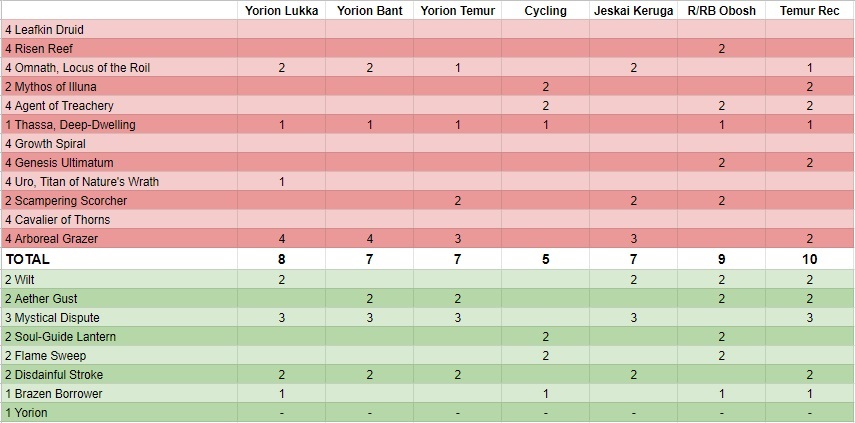
Yorion Lukka Fires – Very Good

Against Yorion Lukka Fires
Jeskai has slightly better midgame. Both decks don’t interact much, so if they have Fires, Lukka, and a random token on turn five, we can’t do much. To be honest, not many decks without counterspells can beat that start. With turn four Fires into turn five Lukka they can cast Yorion for free, exile Agent, Lukka, and Fires, and use mana they saved on previous plays for another spell. Fortunately for us, it doesn’t happen that often, as they also have 80 cards, and finding all three pieces together is not that easy, and if they don’t ‘kill us’ on turn five, late game is ours. If you watched the video, you probably know what I’m saying right now.
The real game starts postboard, where both players have some interactions. Overall it makes things better for us, as their main gameplan (Fires) doesn’t let them interact during our turn. We should always counter Fires on turn four/five if we can, but later in the game it loses its power, to the point where it even helps us resolve Agent or Ultimatum. Every time they play Fires try to think if you really should counter that. Especially if they don’t have many cards in hand, it might be correct to let the enchantment resolve, counter the second spell, and take your turn with 100% to resolve everything you want.
Yorion Bant – Very Good

Against Yorion Bant
Bant players play a ‘fair game’ against us. They use mana to cast their spells (sounds weird to write that, but that’s kinda unusual nowadays…), and don’t have clear auto-win hands like Yorion Lukka Fires. On the other hand, they do interact with us using counterspells. Don’t rush your best spells into open mana. Thanks to Reefs and Cavaliers, we usually have more mana and more cards in hand later in the game. It’s usually better to play ‘medium threats’ like Reef, or Omnath, even if we have mana for Ultimatum or Agent, if they can counter it. This way, they either lose a counterspell on something that is not as relevant, or lose mana that they kept for this counterspell, while we get some small value. Use the best spells when they tap out, or you believe they ran out of counters.
The best targets for 《Mythos of Illuna》 are Agent and 《Elspeth Conquers Death》 (to answer their ECD), sometimes maybe Reef, if you can safely resolve it on turn four. Once I even managed to copy Omnath for lethal, but that doesn’t happen too often against the deck with four 《Shatter the Sky》.
Mirror – Even

Against Mirror
Not much to say here. Game one is pretty much random, just ramp as fast as possible and hope your Agent and/or Ultimatum come faster than opponent’s. Postboard it gets a little trickier, as both players get access to counterspells. Game plan stays the same, fast ramp and powerful spells, just be careful to don’t play Ultimatum right into one mana 《Mystical Dispute》. Usually the player who has more mana in the mid/late game wins, so don’t be afraid of countering turn two 《Growth Spiral》 with Dispute, or turn three Uro with 《Aether Gust》. Fight for mana early, to take advantage over the game. Even though we want to have as many lands as we can, 《Arboreal Grazer》 isn’t a good card in the match up. 0/3 non-Elemental body is worthless, so use Spiral/Uro/Reef/Cavalier (all those cards give you one card back, when resolve) to ramp instead. There’s nothing worse than drawing two Grazers and being with one card in hand on turn five.
Cycling – Even

Against Cycling
It’s all about 《Flourishing Fox》. If they have it on turn one it’s hard to win, as their deck is really consistent, and spot when Fox doesn’t grow is very very rare. Usually they deal enough damage with it, to kill us with the first 《Zenith Flare》, and we can’t do much about it. Without the one mana 《Tarmogoyf》 they’re way too slow, and we can take control over the game without any problems. 《Soul-Guide Lantern》 is great in the match up, as the main ability costs zero, so we can play it whenever we have one spare mana, and then wait with it until opponent casts Flare or Lurrus. As a nice bonus, we can find it with 《Genesis Ultimatum》!
《Brazen Borrower》 is my last minute anti-cycling addition, as the main answer for the Fox in every stage of the game. It’s usually better to not use it on turn two (unless we have a good play for turn three and four!) and wait for it to be at least 5/5. Let your opponent lose more of their resources! The same goes with Grazer. Don’t chump-block the 3/3 on turn two. The longer you wait, the more damage you prevent while blocking! Obviously try to stick out of Flare range, so don’t wait too long 😀
Jeskai Fires Keruga – Very Good

Against Jeskai Fires Keruga
Unfortunately for us, deck doesn’t see a lot of play right now, mostly because of its bad match up versus Yorions. Thanks to 《Fires of Invention》 they don’t really interact with us, so our goal is to ramp quickly, and close the game with Agent or Ultimatum. One important note: Fires is bad on our side. We usually have enough lands and cards to cast more than two spells in the late game, so stealing the enchantment with Agent is very dangerous. Do it only if you really feel you have to ‘destroy’ opponent’s Fires, and you don’t have any other way to do so.
R / RB Obosh – Even / Good

Against R / RB Obosh
It all comes down to good mulligans. Thanks to the Companion we always know, we’re playing against this kind of aggro, and it’s important to mulligan accordingly. Look for Grazer and/or 《Leafkin Druid》. 0/3 body + ramp is all what we need to stop angry army of one drops from killing us before we take control over the game. Never keep slow hands against them! It’s also the only aggro match up, where we keep Mythos, as it’s our main removal for Obosh (copy their Obosh and fight, so they both deal 6 damage to each other). 《Wilt》 comes only versus Rakdos version, as they have 《Witch’s Oven》 and 《Heraldic Banner》. For Mono Red don’t board it in, and keep 《Scampering Scorcher》 instead. Three blockers are quite good versus army of one drops without utility, or even with blocking big 《Anax, Hardened in the Forge》 (Obosh decks don’t have access to 《Embercleave》).
Temur Reclamation – The Worst Match Up In Standard

Against Temur Reclamation
Let’s be honest. Our deck can’t pick up a fair fight against Temur Rec. They have better late game with 《Wilderness Reclamation》 + 《Expansion/Explosion》, and a lot of answers for our threats in the form of counterspells. On the other hand we can’t really stop them from doing their stuff. Definitely wouldn’t recommend Elementals in metagame full of Reclamation. Fortunately for us, it’s Temur Clover what won the MagicFest Online Finals (another good match up for us), and the best performing deck during the weekend was Mono Red Obosh (which has a great match up vs Temur Reclamation). I’m really looking forward to play Yorion Elementals again. In the end, having one very bad match up is completely fine, and I don’t expect Temur Rec to dominate Standard. It just has too many bad match ups with other decks.
Conclusion
If you have any questions, as always, find me on Twitter, and ask below the post with this article. I’ll be more than happy to answer!
Have a great day!


